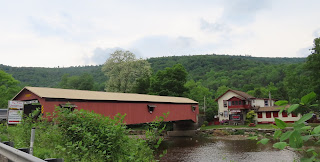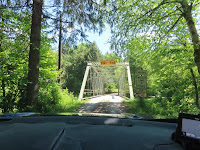We moved the Lazybrook Park for the 14th annual NEPA Bluegrass Festival. Every June, dozens of traditional and progressive bluegrass bands take the stage at the NEPA Bluegrass Festival in Tunkhannock, PA. This three-day event included food and craft vendors, workshops, and tons of bluegrass on two stages. We had the perfect campsite halfway between both stages and across from the jam tent.
The looming presence at Lazybrook Park is the big red bridge! This eight panel structure was built by the Corrugated Metal Company. This company was known for bridges such as the Pierceville Bridge, a patented type of truss known today as the lenticular truss. These bridges feature a beautiful and distinctive shape to them that is unique enough that they can be considered among the rarest types of bridges remaining in the country. The preservation of each surviving lenticular truss bridge is absolutely essential. Having been built by the Corrugated Metal Company, this is among the earliest examples of a lenticular through truss. It is also remarkably complete, with very few alterations. This is also one of the only bridges where the Historic Bridge Inventory itself strongly advocates for the preservation of the bridge. In June, 2015, a project to relocate and restore this historic bridge to nearby Lazybrook Park for non-motorized traffic began. As of summer 2018 the project is complete and the bridge is open. The preservation of the Pierceville Bridge is truly a historic moment for Pennsylvania. The Pierceville Bridge preservation project was an in-kind restoration of the bridge, the first of its kind in Pennsylvania.
The jam tent has impromptu music from about 11am until close to 1am! Oh, it was so great! Our friend, Jay Busch, led a few of the jam sessions. They play like a true jam circle. They go around the tent and each person leads the group in a song. No one is left out, unless they choose to pass, and everyone can join in.
Some of the entertainers we saw included, the Baker Family. The Baker Family was on season 12 of America’s Got Talent. They are a high energy bluegrass band located in south central Missouri. They travel throughout the US. The band members include, Carrie Baker (the mother) plays guitar and upright bass; Trustin Baker (22 years old) playing Fiddle, Banjo, and lead vocals; Carina Baker (19 years old) playing mandolin, lead vocals, and harmony; Elijah Baker (17 years old) plays lead guitar and upright bass.
Doyle Lawson is an American traditional bluegrass and Southern gospel musician. He is best known as a mandolin player, vocalist, producer, and leader of the 6-man group Doyle Lawson & Quicksilver. They are a great group, but times are changing as Doyle Lawson, a 43 year veteran leader of Doyle Lawson & Quicksilver, has announced that he will be stepping away from that role at the end of 2022. With nearly six decades as a professional bluegrass entertainer under his belt, Lawson is clearly the reigning senior statesman in our music. Still active as a touring artist, he plays regularly at festivals. He started on banjo with Jimmy Martin in 1963, who he had known back home in Sneedville, TN for several years. Years later he joined up with JD Crowe and The Kentucky Mountain Boys on guitar, but soon switched to mandolin. Doyle was back to Jimmy’s band in ’69 for a short time, but returned to Crowe until ’71. That was when he joined Charlie Waller and The Country Gentlemen, the beginning of an epic eight year stint that saw him participate in several landmark recordings, none more so than 1972’s The Award Winning Country Gentlemen. In 1979, history was made with the debut of Doyle Lawson & Quicksilver.
On the Progressive Stage we heard Mama Corn. One of the Keystone state’s hottest bluegrass bands. Evident at those early sessions was an undeniable chemistry between several of us who shared a love for old time Appalachian folk and bluegrass music, so the idea of building a band was discussed. This quartet has become a mainstay on the regional bluegrass festival circuit. Featuring multi-talented singer-songwriters; utilizing guitar, banjo, dobro, harmonica, mandolin, upright bass and remarkable vocal harmonies, the spirit of traditional roots music is echoed in their sets. After the formal line up was set, they started rehearsing as a band at the famous "Bait Shop" rehearsal studios in early 2007, and "Mama Corn" was born. Right from the first rehearsals there was a lot of potential and they knew they had something special. Their first showcase was at a local watering hole called "The Hitching Post" where the owner was a bluegrass enthusiast. Their self-titled album, "Mama Corn", was completed in June of 2011 and was met with good reviews. They have played venues including The Rochester International Jazz Festival.
One of the main reasons we decided to come to the NEPA festival was the Malpass Brothers. As young boys, Christopher and Taylor Malpass soaked up the music of their granddad’s phonograph records. Christopher earned his first talent show trophy at age 7, and Taylor was playing mandolin by the time he was 10. Today, they promote the work and music of classic country artists they treasure while creating new music and making their own mark in the lineage of a rich American cultural heritage. With sincerity, honesty and an utter ease on stage that belies their years, their smooth vocal blend and skillful musicianship layer infectiously into the deep respect they pay to legends who have paved the way. Add the funny, off-the-cuff quips between the two 20-something siblings, and the engaging concert becomes a magnetic time-traveling journey to when a calmer rhythm reigned supreme. The Malpass Brothers toured with the late Don Helms, former steel guitarist for Hank Williams, have opened for music legend Merle Haggard on multiple tours and appeared on stages from the Shetland Islands to Ryman Auditorium to Merlefest. Their most recent self-titled recording, produced by bluegrass legend Doyle Lawson, was released by Crossroads’ Organic Records in 2015.
We made a side trip to the Tunkhannock Creek Viaduct or the Nicholson Bridge. Among the greatest bridges in the world is the famous Tunkhannock Viaduct, which has been called the 9th Wonder of the World. It is just passing a century old milestone, the Tunkhannock Viaduct still creates an impressive sight in northeastern Pennsylvania. It took three years to build, the massive reinforced concrete bridge that stretches out almost a half mile. Its graceful central arches are supported by piers that were sunk 138 feet below ground level.
To complete the bridge, the contracting firm of Flickwir and Bush employed a workforce of about 500 men, some of whom worked nearly 300 feet off the ground on and around temporary construction towers and cables. In the course of work, two men fell to their deaths. Soaring high above the valley floor, Tunkhannock Viaduct stretched for 2,375 feet across ten 180 foot arches and two 100 foot arches. It consumed 167,000 cubic yards of concrete (about 350,000 tons) and 1,140 tons of reinforcing steel. When completed in 1915, it was twice as long and more than twice as high as the 1848 stone-arch Starrucca Viaduct, which lies about twenty-five miles northeast of Nicholson.
This amazing structure, rising 240 feet above the creek bed, was built by the Delaware, Lackawanna, and Western Railroad. A key link in the railway, the project was designed to straighten out existing curves and steep grades of the previous tracks where trains often struggled through these rugged Pennsylvania hills. Considered a marvel in engineering at the start of the 20th century, the bridge shaved more than an hour from a freight train's schedule.
This majestic bridge is still in use today by the Canadian Pacific and Norfolk Southern Railroad. Also called the Nicholson Bridge, the viaduct looms over the small Nicholson Township.
Difficult to escape its presence, Nicholson celebrates Bridge Day every September.
Stay tuned to follow the next stops on our #TwoLaneAdventures



































































